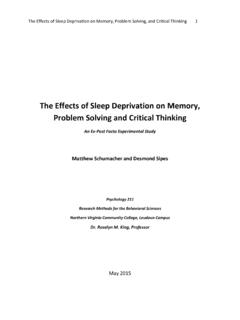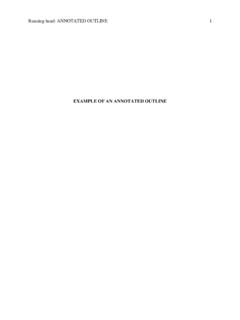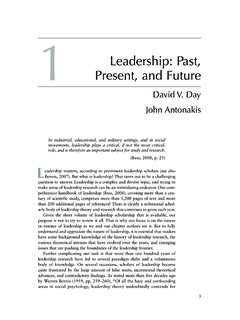Transcription of Phenomenological Research Methods
1 Phenomenological Research Methods Clark Moustakas, Sage Publications, Thousand Oaks California, 1994 I Human Science Perspectives and Models Moustakas starts with discussing different human science perspectives and models. He illustrates five human science Research approaches that utilize qualitative methodologies: ethnography, grounded theory , hermeneutics, empirical Phenomenological Research and heuristic Research . Ethnography means the direct observation of the activities of a certain group as well as communication and interaction with the group members. The result of ethnographic Research is a cultural description. In the grounded theory approach data is collected and the hypotheses and concepts based on data analysis are worked out during the study . Hermeneutics involves the art of reading text or experiences in such a way that the intention and meaning behind the appearances are understood.
2 The point of view is known as well as the cultural and social forces that may influence it. Here Moustakas quotes Gadamer, who claims that the starting points of hermeneutic studies are to be found in art and in philological-historical insights. Gadamer believes that the autonomy of viewing art from the vantage point of the history of style has been shaken by hermeneutical reflection (..) including shake up of fixed presuppositions. (Gadamer 1976, p. 38-39). Empirical Phenomenological Research returns to experience in order to obtain comprehensive descriptions. These descriptions then provide the basis for a reflective structural analysis to portray the essences of the experience. First the original data is comprised of na ve descriptions obtained through open-ended questions and dialogue. Then the researcher describes the structure of the experience based on reflection and interpretation of the Research participant s story.
3 The aim is to determine what the experience means for the people who have had the experience. From there general meanings are derived. Heuristic Research begins with a personal question or challenge, but one that has a social or universal significance. It is aimed at discovery through self-inquiry and dialogue. The life experience of the heuristic researcher and the Research participants is not a text to be interpreted but a full story that is vividly portrayed and further elucidated through art and personal documentations. From these individual depictions and portraits from Research participants, a composite depiction is developed. This represents the entire group of co-researchers. The primary researcher then develops a creative synthesis from this material. These models have certain common qualities (Moustakas p. 21): - They recognize the value of qualitative designs and methodologies.
4 Studies of human experiences are not approachable through quantitative approaches. - They focus on the wholeness of experience rather than solely on its objects or parts - They search for meanings and essences of experience rather than measurements and explanations - They obtain descriptions of experience through first-person accounts in informal and formal conversations and interviews - They regard the data of experience as imperative in understanding human behaviour and as evidence for scientific investigations - They formulate questions and problems that reflect interest, involvement, and personal commitment of the researcher - The view experience and behaviour as an integrated and inseparable relationship of subject and object and of parts and whole II Transcendental Phenomenology: Conceptual Framework. Moustakas then proceeds by presenting Husserl s ideas on transcendental phenomenology.
5 Phenomenology attempts to eliminate everything that represents a prejudgement or presupposition. It requires to look at things openly, undisturbed by the habits of the natural world. The challenge is to describe things as they are, to understand meanings and essences in the light of intuition and self-reflection. Meaning is created when the object as it appears in our consciousness, mingles with the object in nature: what appears in consciousness is an absolute reality while what appears to the world is a product of learning Moustakas explains (p. 27). The act of consciousness and the object of consciousness are intentionally related. Intuition is therefore essential in describing whatever presents itself and in his transcendental philosophy Husserl preferred using intuition over deduction. III Phenomenology and Human Science Inquiry The relation between phenomenology and human science inquiry has once been complex.
6 Transcendental science grew out of a discontent with science based exclusively on studies of material things. According to phenomenologists, science failed to take into account the consciously experiencing person. Husserl s phenomenology is transcendental because it adheres to what can be discovered through reflection on subjective acts and their objective correlates. It asserts that the only thing that we know for certain is that which appears before us in our consciousness, and that fact guarantees its objectivity. To understand the objects that appear before us we must return to the self, to know and recognize ourselves in the experience that is investigated. Transcendental phenomenology is a scientific study of the appearance of things, of phenomena just as we see them and as they appear to us in our consciousness. Every of these phenomenon can be a suitable starting point for reflection.
7 The challenge is to explicate the phenomenon in terms of its constituents and possible meanings. Thus we can discern the features of consciousness and arrive at an understanding of the essences of the experience. Whether the object actually exists or not makes no difference, things can as well emerge in our consciousness. Husserl preferred to use the word act to refer to experiences of meaning, since the meaning of a phenomenon is in the act of experiencing it, and not in the object itself. Acts are intentional experiences. Intentional experiences are the combination of the outward appearance of something and how it looks like inside your head , based on memory, image and meaning. Perception is regarded as the primary source of knowledge. Intentions and sensations make up the full concrete act of perception and allow the object to achieve full bodied presence. Phenomenology commits itself to descriptions of experiences, not explanations or analysis.
8 The data of experience, your own thinking, intuiting and judging are primary evidences of scientific investigation. In Phenomenological Research the researcher also has a personal interest in the Research question. For this Husserl starts from the presupposition that one can achieve a pure and absolute transcendental ego, that one can be totally unbiased, and without Another presupposition is that that what appears to be appearing is actually appearing (Moustakas p. 61): one sees what or who one sees. IV Intentionality, Noema and Noesis Intentionality, noema and noesis are concepts central to phenomenology. Noema is that which is experienced. Noesis is the way in which it is experienced. Both terms refer to meanings. Husserl s back to things themselves is a way of emphasizing knowledge that is rooted in meanings, rather than in an analysis of physical objects. In reflecting on what one has seen , one will start to grasp meanings that have been concealed.
9 The challenge is to look, look again and keep looking and reflecting to obtain complete descriptions. Shifts occur when one looks from a different angle, a different frame of reference, a different mood. No perception of a thing is conclusive and deeper layers of meaning may always unfold when you keep searching. To finally arrive at essences of a phenomenon one must unify the noema (external perception) and the noesis (internal perception). V Epoche, Phenomenological Reduction, Imaginative Variation and Synthesis Other important principles of Phenomenological Research are epoche, Phenomenological reduction, imaginative variation and synthesis. First person reports of life experiences are what makes Phenomenological Research valid. The freedom from suppositions needed for this is named Epoche: things can not be felt to be known in advance or felt to be known without internal reflection and meaning.
10 Only your own perception can point to truth. After epoche comes Phenomenological reduction: describing just what you see, external and internal, the relationship between phenomenon and self. You look and describe again and again, always with reference to textural qualities like rough and smooth, small and large, angry and calm, colourful or bland,.. : descriptions with a context in experiencing. This is transcendental because it uncovers the ego and Phenomenological because it transforms the world into mere phenomena. It s called reduction because it leads back to our own experience of the way things are (Schmitt 1968 p. 30). Because it is a never-ending process the approach of this unlimited possibility for discovery is called horizonalization. The next step in the Research process is that of imaginative variation: varying the frames of reference and the perspectives, employing polarities and reversals.


